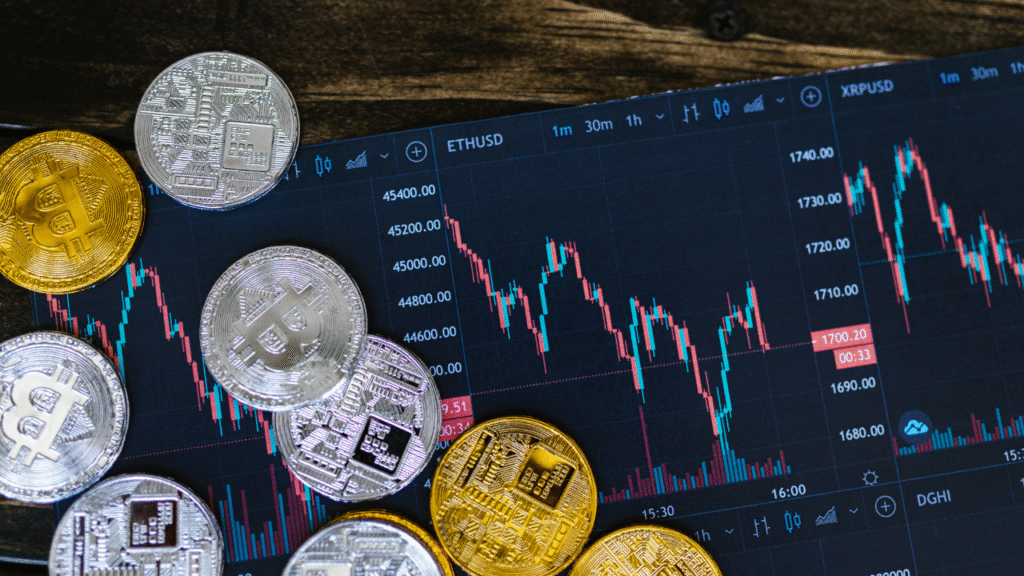Altcoins can feel like a candy store—so many choices, so little clarity! If you’ve wondered whether these Bitcoin alternatives are opportunity or overhype, you’re in the right place. In this altcoin investing guide, I’ll break down what altcoins are, why they exist, and how to separate potential winners from risky fliers. We’ll cover types of altcoins, real pros and cons, a simple research framework (so you’re not guessing), and practical allocation tips. No jargon walls, no moon promises—just a clean plan to help you decide if, when, and how altcoins fit your portfolio.
📝 Want the full breakdown? Read our in-depth Project Serenity review to see if it’s the right crypto investment guide for you.
💡 What Are Altcoins?
Altcoins are simply any cryptocurrency that isn’t Bitcoin—yes, that even includes Ethereum (ETH). While Bitcoin was the first and still holds the largest market dominance, altcoins emerged to address gaps, test new technologies, and serve unique use cases.
They exist because the crypto space thrives on experimentation. Developers wanted to improve transaction speeds, lower costs, introduce smart contracts, create privacy features, or even design tokens for specific industries like gaming, finance, or data storage.
When compared to Bitcoin:
- Purpose – Bitcoin focuses on being a secure, decentralized store of value, while altcoins often aim to innovate, add new functionalities, or target niche markets.
- Security – Bitcoin’s network is the most battle-tested and secure, but some altcoins use newer consensus methods that trade maturity for efficiency.
- Adoption – Bitcoin enjoys wider recognition and acceptance, yet certain altcoins dominate specific sectors, such as Ethereum in decentralized applications or Polygon in scaling solutions.
📈 Unlock exclusive insights with Marco Wutzer’s Project Serenity before the next wave hits.
🪙 Major Types of Altcoins (with Examples)

The altcoin market is incredibly diverse, with different categories serving unique roles in the crypto ecosystem. Here’s a breakdown of the major types you’ll encounter:
🔗 Layer-1 & Layer-2 Solutions
- Layer-1: Base blockchains like Ethereum (ETH) and Solana (SOL) that host decentralized applications and smart contracts.
- Layer-2: Scaling solutions like Optimism (OP) and Arbitrum (ARB) designed to improve transaction speed and reduce costs.
💱 DeFi Tokens
- Power decentralized exchanges, lending platforms, and derivatives protocols.
- Examples: Uniswap (UNI) for swapping tokens, Aave (AAVE) for crypto lending/borrowing.
🛠 Infrastructure & Data
- Provide essential blockchain tools like oracles and interoperability solutions.
- Examples: Chainlink (LINK) for real-world data feeds, Cosmos (ATOM) and Polkadot (DOT) for cross-chain communication.
💵 Stablecoins
- Pegged to stable assets (like USD) for payments, savings, or hedging against volatility.
- Examples: USDC, USDT—critical for trading and DeFi liquidity.
🚀 Narrative Sectors
- Emerging trends like AI, Real-World Assets (RWA), gaming/metaverse, privacy, and restaking tokens.
- Often see rapid price moves when narratives gain hype.
🐕 Meme & Community Coins
- Driven by sentiment, community memes, and viral culture.
- Examples: Dogecoin (DOGE), Shiba Inu (SHIB)—high risk, high volatility, and often unpredictable.
💼 Explore the full benefits of Project Serenity here and see if it fits your investing goals.
📈 Pros of Altcoin Investing

Altcoins can offer unique advantages for investors willing to take on additional research and calculated risk. Here’s why many traders and long-term holders include them in their portfolios:
🚀 Higher Upside Potential
- Historically, during bull markets, certain altcoins have outperformed Bitcoin and Ethereum in percentage gains.
- Smaller market caps allow for faster price appreciation when adoption or hype increases.
💡 Access to Innovation and New Narratives
- Many altcoins pioneer cutting-edge blockchain technologies like DeFi, AI integrations, gaming economies, and real-world asset tokenization.
- Early exposure to emerging narratives can lead to outsized returns if the project gains traction.
📊 Diversification Across Sectors
- Spreading investments across multiple use cases (payments, infrastructure, DeFi, data solutions, NFTs, etc.) can help reduce portfolio risk.
- Allows investors to capture growth from different market sectors rather than relying on a single asset class.
💵 On-Chain Yield Opportunities
- Many altcoins offer staking rewards, liquidity provision (LP) incentives, or governance participation benefits.
- Yield generation can help offset volatility and grow holdings even in sideways markets.
⚠️ Cons & Risks of Altcoin Investing
While altcoins can present exciting opportunities, they also carry heightened risks compared to Bitcoin or Ethereum. Here’s what every investor should consider:
📉 Extreme Volatility & Deeper Drawdowns
- Altcoins often experience larger percentage drops than BTC during market downturns.
- Rapid price swings can trigger emotional trading decisions and unexpected losses.
🔐 Security Risks in Smart Contracts & Protocols
- Vulnerabilities in smart contracts, bridges, and protocols can lead to hacks or exploits.
- Even well-known projects have suffered significant losses due to security breaches.
🪙 Tokenomics Dilution
- High emissions, large insider allocations, or early investor unlocks can flood the market, suppressing price growth.
- Poorly designed tokenomics can erode long-term value.
💧 Liquidity Challenges
- Low-volume markets can cause slippage when buying or selling.
- Shallow order books make it harder to exit positions quickly, especially in smaller-cap coins.
⚖️ Regulatory & Delisting Risks
- Some altcoins face regulatory crackdowns, especially in the U.S. and EU.
- Exchanges may delist tokens due to compliance issues, impacting liquidity and accessibility.
🔄 Correlation with Bitcoin in Macro Shocks
- Despite independent narratives, most altcoins follow BTC’s macro trend during global market stress.
- Diversification within crypto alone may not protect against major downturns.
🔍 Learn more about Project Serenity’s T4 investment strategy and how it identifies early-stage gems.
🔍 How to Research an Altcoin (DYOR Framework)

Before investing in any altcoin, applying a DYOR (Do Your Own Research) framework can help you separate high-potential projects from risky traps. One of the most effective methods is the T4 Lens: Technology, Team, Traction, and Tokenomics.
🖥 Technology – Is It Built to Last?
- Identify the problem–solution fit: Does the altcoin solve a real problem, or is it just hype?
- Check if there’s real product progress—mainnet/testnet live, working dApps, or integrations.
- Review code repositories (GitHub, GitLab): commits, developer activity, and open-source credibility.
- Look for audits, bug bounties, and incident history to assess security maturity.
👥 Team – Who’s Behind the Project?
- Research founders and developers: Are they doxxed with verifiable experience?
- Look for backing from reputable investors or accelerators.
- Check community engagement: Are updates transparent and regular?
📊 Traction – Is There Real Adoption?
- On-chain metrics: users, TVL (Total Value Locked), transaction fees, and retention rates.
- Off-chain growth: Partnerships, integrations, and brand collaborations.
- Community health: Organic engagement vs. bot activity.
🪙 Tokenomics – Can It Sustain Value?
- Examine supply, emissions, and unlock schedules.
- Assess utility: governance, staking, fee payments, or access to exclusive features.
- Understand value accrual: how holding the token benefits investors over time.
🛡 Competitive Positioning – Can It Win Long Term?
- Map the competitive landscape: Who else is solving the same problem?
- Evaluate moats: user experience, performance, partnerships, or network effects.
📚 Tokenomics 101 (Value Accrual Basics)
Understanding tokenomics is critical before you invest in any altcoin. It determines how value flows through the ecosystem—and whether you, as an investor, stand to benefit in the long run.
📦 Supply Structure
- Max Supply – The absolute cap on how many tokens will ever exist.
- Total Supply – Current number of minted tokens, whether circulating or locked.
- Circulating Supply – Tokens actively in the market and available for trade.
- FDV (Fully Diluted Valuation) vs. Market Cap – FDV assumes all tokens are in circulation, giving you a long-term valuation perspective. Market cap reflects only what’s currently circulating.
📈 Emissions & Unlocks
- Cliffs – Period before locked tokens start releasing.
- Vesting Schedules – Gradual release of team, investor, or ecosystem tokens over time.
- Schedule Risks – Large upcoming unlocks can cause price drops due to sell pressure.
🛠 Utility of the Token
- Fees – Used for paying network or transaction fees.
- Staking – Tokens locked to secure the network and earn rewards.
- Governance – Voting rights on protocol changes.
- Burns – Permanent removal of tokens to reduce supply.
💡 Who Benefits & When
- Identify who gets tokens first: early investors, team, or community.
- Understand when value accrues: is it at launch, after adoption, or via steady long-term growth?
- Watch for economic misalignments where insiders dump before retail investors benefit.
📊 Measuring Traction & Adoption

Evaluating a crypto project’s traction and adoption is essential for judging its real-world potential beyond hype. A token can have a beautiful whitepaper and flashy marketing, but without measurable growth and usage, it’s often just smoke and mirrors.
🔗 On-Chain Metrics
- Active Addresses – Number of unique wallets interacting with the protocol over time.
- TVL (Total Value Locked) – How much capital is committed in the ecosystem.
- Fees & Revenue – Amount the network generates from actual usage.
- Retention Rates – Whether users keep coming back after initial interaction.
🌐 Off-Chain Indicators
- Integrations & Partnerships – Connections with other protocols, payment systems, or major brands.
- Exchange Listings – Availability on high-liquidity platforms (CEX & DEX).
- Developer Ecosystem – Activity in building tools, dApps, or plugins for the chain.
👥 Community & Support Quality
- Organic Engagement – Real users vs. bot accounts inflating follower counts.
- Documentation Depth – Clear, updated guides for users and developers.
- Support Channels – Active, responsive help via Discord, Telegram, or forums.
🧠 Get access to advanced crypto research inside Project Serenity—designed for serious investors.
🛡 Security, Audits & Admin Controls
When evaluating any altcoin or crypto project, security is a non-negotiable pillar. Strong fundamentals mean nothing if the protocol can be exploited or manipulated. Here’s what to check:
🔍 Audit Details
- Audit Firms – Look for reputable names like Trail of Bits, CertiK, Quantstamp, or OpenZeppelin.
- Scope & Dates – Verify the coverage (core contracts, governance, token contracts) and when the audit was completed. Recent audits carry more weight.
- Ongoing Bounties – Active bug bounty programs on platforms like Immunefi signal proactive security measures.
🔑 Admin Controls
- Admin Keys – Identify if a single party can upgrade contracts, pause the protocol, or mint tokens.
- Pause/Mint Powers – Centralized powers should ideally be time-locked or restricted.
- Multisig Governance – A well-distributed multi-signature setup reduces the risk of unilateral malicious actions.
📡 Oracle & Incident Response
- Oracle Design – Check if they use robust price feed systems (like Chainlink) to prevent manipulation.
- Prior Incidents – Review past exploits, the team’s response time, and the fixes implemented.
- Post-Mortems – Public and transparent incident reports show accountability.
💧 Liquidity & Market Structure
When evaluating an altcoin investment, understanding its liquidity and market structure is critical for assessing both entry and exit risks. Even strong projects can be poor investments if they lack sufficient trading depth or have unhealthy holder distribution.
🏦 Exchange Listings & Depth
- CEX/DEX Listings – Identify where the token is listed (major CEXs like Binance, Coinbase, or top DEXs like Uniswap, Curve).
- Depth & Slippage – Test how much capital you can move without significant price impact. Shallow order books can create large slippage even on moderate trades.
👥 Holder Distribution
- Top Wallet Concentration – Check what percentage of supply is held by the top 10–20 wallets.
- Exchange vs. Contract Wallets – A high percentage on exchanges may signal speculative trading, while contract wallets may indicate staking or protocol locks.
📊 Volume Quality & Supply Overhang
- Wash-Trading Risks – Look for suspiciously high volume without corresponding depth or real liquidity.
- Airdrop/Unlock Overhang – Monitor upcoming token unlock schedules that may flood the market and depress price.
💡 See why crypto insiders trust Project Serenity for timely, well-researched portfolio updates.
📈 Building an Altcoin Portfolio (Core–Satellite)
Creating a balanced altcoin portfolio isn’t about buying every promising token—it’s about structuring your holdings so your core remains strong while still capturing upside from high-potential projects.
🪙 Keep a BTC/ETH Core
- Bitcoin and Ethereum form the foundation of most crypto portfolios due to their market dominance, liquidity, and established adoption.
- Aim for your core holdings to represent at least 50–70% of your crypto allocation.
🛰 Add Altcoins as Satellites
- Treat altcoins as high-upside, higher-risk satellites orbiting your core.
- Focus on projects with clear fundamentals and use cases.
📏 Sizing Guide & Exposure Caps
- Allocate 1–3% of your total portfolio to each speculative altcoin.
- Cap total altcoin exposure to 30–40% to avoid overexposure to volatility.
⏳ Entry Strategy – DCA
- Use Dollar-Cost Averaging (DCA) to build positions over time.
- Set invalidation levels where you’ll cut losses and take-profit tiers to secure gains.
🔄 Rebalancing Rules
- Monthly or quarterly reviews help maintain your risk levels.
- Rebalance by trimming overperformers and adding to undervalued but still high-conviction plays.
🎯 Entry & Exit Tactics
Planning your entries and exits is just as important as picking the right altcoins. The goal is to maximize upside while managing downside risk—without letting emotions take over.
⏳ Combine DCA with Event-Based Adds
- Use Dollar-Cost Averaging (DCA) to build your position gradually.
- Add extra buys during key catalysts like mainnet launches, major exchange listings, or strong partnership announcements.
📉 Define Stop-Loss & Profit Targets
- Decide in advance the maximum loss you’re willing to take per position.
- Set profit-taking tiers—scaling out when price strength accelerates to lock in gains.
- Avoid “all-in” or “all-out” moves; gradual scaling reduces timing risk.
💰 Track Taxes & Fees
- Keep a log of trades, fees, and cost basis for each asset.
- Be aware of tax implications in your jurisdiction, especially for short-term gains.
- Minimize overtrading—small transaction costs and spreads can eat into profits fast.
✅ Claim your spot in the Project Serenity community today and get real-time portfolio alerts.
🛠 Tools & Resources for Altcoin Investors
Having the right crypto tools can make a huge difference in tracking your portfolio, researching projects, and spotting opportunities before the crowd. Here’s a solid toolkit to support your altcoin investing journey.
📊 Trackers
- CoinStats – Sync multiple wallets and exchanges for real-time portfolio tracking.
- Delta – Beautiful interface with price alerts and performance analytics.
- Zapper – Track DeFi positions across multiple chains.
- DeBank – Ideal for monitoring wallet activity and DeFi protocols.
🔍 Explorers & Analytics
- Etherscan – Ethereum’s go-to blockchain explorer for transactions, holders, and contract data.
- Dune – Custom analytics dashboards with real-time blockchain data.
- DeFiLlama – Track Total Value Locked (TVL) and DeFi protocol stats.
- Token Terminal – Analyze project fundamentals like revenue, fees, and token economics.
📰 News & Research
- Messari – Deep project reports, market insights, and data.
- CoinDesk – Daily news and updates on the crypto market.
- Bankless – Educational content on DeFi, altcoins, and blockchain innovation.
- Project Forums/GitHub – Direct communication channels and code updates from the development team.
🔐 Discover how Project Serenity helps manage risk in volatile markets with expert-led strategies.
🚫 Common Mistakes to Avoid in Altcoin Investing
Even experienced investors can trip up when it comes to altcoins. Here are the biggest pitfalls to watch for so you can protect your capital and stay strategic.
📈 Chasing Hype Without Research
Jumping into a project just because it’s trending on X (Twitter) or Reddit is a recipe for buying high and selling low. Always validate the fundamentals before committing capital.
💸 Holding 20+ Tiny Positions With No Conviction
Owning too many micro-cap coins spreads your attention and reduces the impact of your winners. Focus on fewer, higher-conviction plays with solid narratives.
📅 Ignoring Unlock Calendars, Fees, or Tax Impact
Large token unlocks can cause heavy sell pressure. Trading fees and capital gains taxes can eat into profits if you don’t plan ahead.
🔐 Neglecting Security and Self-Custody
Keeping altcoins on exchanges exposes you to hacks, freezes, and insolvencies. Use hardware wallets and back up seed phrases securely.
🏁 Conclusion – Altcoin Investing in Perspective
Altcoins can be your ticket to early-stage innovation and outsized gains — but they also come with amplified risks. The key is balance. Keep a strong BTC/ETH core, treat altcoins as satellites, and size them with discipline so no single loss derails your portfolio.
Use a structured DYOR framework before buying, focusing on fundamentals like technology, team, traction, and tokenomics. Review your portfolio regularly, keep security tight with self-custody, and stay alert to market cycles and unlock schedules.
💡 Action Step: Bookmark this guide, apply the research checklist to every new project, and set a recurring review date to refine your altcoin strategy over time.
🚀 Start your crypto journey with Project Serenity and discover smarter investment strategies.

